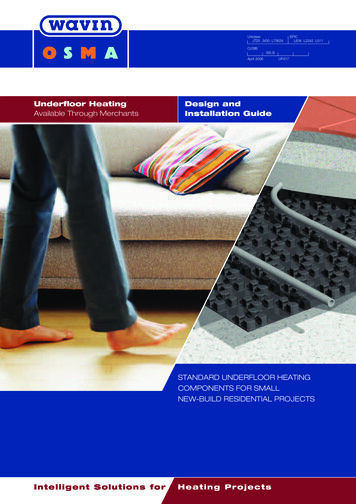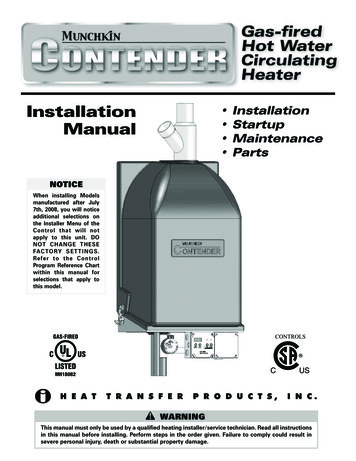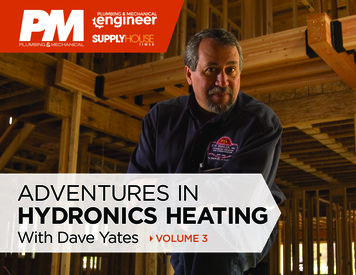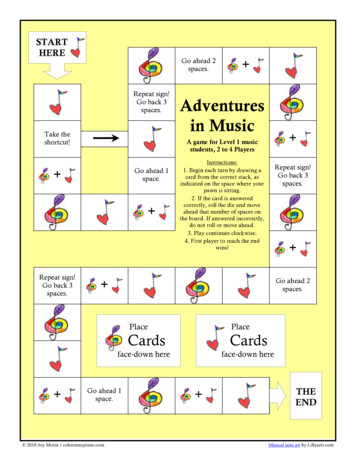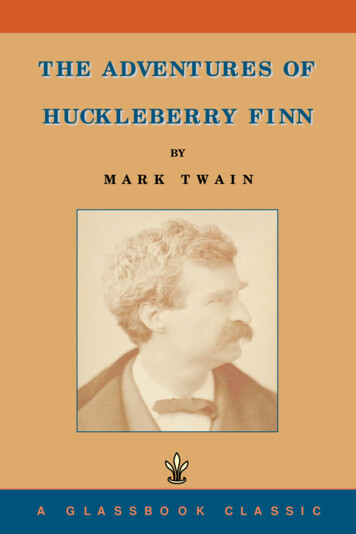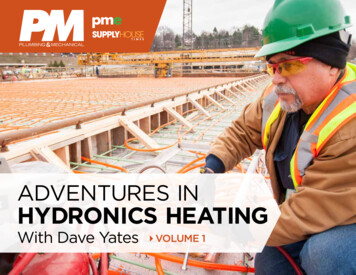
Transcription
ADVENTURES INHYDRONICS HEATINGWith Dave YatesVOLUME 1
A SPECIAL MESSAGEFROM DAVID YATES
THANK YOU TO OUR SPONSORS
CONTENTS2020 VOLUME 1EDUCATIONALCOLUMNSCASEHISTORIES6You Ask; They Tell; You Sell35Icebomb!8We don’t know what we don’tknow, but we sure can learn!38Dumb as a box of rocks41In harm’s way43How to meet snow-melt system challenges45Profit from math47Technology pains10Return on Investment14What’s in your radiant toolbox?17A Roadmap to energy conservation25The chicken or the egg?27Mastering the outdoor reset curve29No heat-loss calculation?No work for you!31PVC combustion ventingSPECIALWHITE PAPER50The biggest loserDave Yates began his career in the PHCP-PVF trades in 1972 with F. W. Behler, a third-generation plumbing/ HVAC firm he purchasedin 1985. Yates also is an experienced teacher in the hydronics industry, serving as an adjunct professor and on the Technical AdvisoryBoard for the Thaddeus Stevens College of Technology. He is is also very active in writing articles for industry trade publicationsincluding BNP Media’s Plumbing Group, attending trade shows and speaking at events. He can be reached at dyates@fwbehler.com.
EDUCATIONALCOLUMNS
YOU ASK; THEY TELL; YOU SELLYou Ask; They Tell;You SellAt the AHR Expo in New York City a few years back, a groupof us were on a panel to discuss things such as up-selling jobsduring the past few “lean” years.One fellow, former longtime industry journalist BobMader, asked me if I could be brief when discussing this issuebecause, “You tend to get wound up and very passionate whendiscussing how to upsell jobs.” Guilty as charged! I gave thatsome thought later that night and came up with a six-wordanswer to upselling — the title of this column. Brevity thatBob could appreciate!In the not-so-distant-past, our customers tended to replacetheir widgets (water heaters, boilers, furnaces, A/C units, etc.)when they were either broken or worn to the point whererepairs were draining their wallets.“High efficiency,” back then, meant an 80% fossil-fueled or8-SEER electric-powered widget. Then along came condensing92% furnaces, followed by boilers, then 95% and even 98%combustion efficiencies, tankless water heaters that went from82% to 98% efficiency and high-SEER/COP heat pumps, ECMmotors (blowers and circulators), inverter-drive mini-splits,and geothermal.Tax credits made the choice to upgrade a no-brainer.Right up until the tax credits stopped (solar and geothermaltax credits sunset in 2016). Upselling became a bit morechallenging.Truth be told, I don’t persuade clients; they sell themselves.If I have a secret, it’s the ability to listen, react and educate. In anutshell, it goes like this:previous /next article6
YOU ASK; THEY TELL; YOU SELL“In order to get past the dollar signs, youneed to draw out their reasons for why youare being asked for a price.”You ask: The art of listening“Are you having trouble with your widget?” That’s almost always myfirst lead-in question after meeting the owner(s). It doesn’t matterif the answer is yes or no! Up until this beginning point of activelistening, they see you as a commodities broker — they will be lookingat you as money-out-the-door and you’d best have the low bid if youwant the work.But it isn’t really just about the price, and don’t ever let anyoneever tell you otherwise. In order to get past the dollar signs,however, you need to draw out their reasons for why you are beingasked for a price.No matter if it’s yes or no, the next question is this: “What are theissues?” That’s what’s called a leading question because it’s not justa yes/no, and it allows me to dig deeper into why they are asking forpricing. What is driving them to seek out costs for a new widget?What I’m looking for are two things that are not technically relatedto the widget: I want to know what’s important to them — and whatis going to elicit an emotional trigger — what really hits home. Minethe conversation for these two golden nuggets and you’re well on theway to a sale.You sell: Solutions? We have solutions!The last part of the sales call got us out of the widget’s area andon to the system. After all, a new widget isn’t going to resolveheating/cooling/hot water/ noise/imbalances/high fuel bills all byits lonesome self. The door is wide open by now for you to educateclients regarding ECV (energy conservation value) and ROI (returnon investment). One of the most common responses by now is:“No one else bothered to ask us questions like this. You’re obviouslyknowledgeable and have a solid grasp of what we need.”If they have been having trouble with their widget(s), they’llreveal the problems, and from that point on you simply needto provide resolution solutions. How cool is this sales tool?They just revealed what they wanted and all you needed to do isprovide the solutions!Ask for the sale: Do this before you leaveBefore you go on any sales call, have some price ranges preparedbased on past experiences. Good, better and best products alongwith some literature to hand them. If you offer financing, this is thetime to go over the details. Explain how you, or your employees,will care for their property during the work and how the job willprogress from start to finish. Tell them you’d like to order their newwidget today and that you would like to schedule the work for a day/time that is convenient for them. If they are hesitant, ask for andaddress any concerns. Ask for the sale again. If they still are not sold,follow up within three days.They tell: Problems, what’s important andwhat they really wanted that drove them to callIn order to pry the real concerns from the potential clients, get themto discuss (with you responding so they realize you are listening andcare) what matters to them by using open-ended questions that startwith: why, describe, what, how, explain, tell me or help me; and avoidyes/no questions like the plague. Get out of the mechanical roomand discuss the system. Studies have shown that the vast majority ofhomeowners are either dissatisfied or somewhat dissatisfied with theirhome’s PHVAC systems.previous /next article7
WE DON’T KNOW WHAT WE DON’T KNOW,BUT WE SURE CAN LEARN!We don’t know what we don’tknow, but we sure can learn!speaking, while PowerPoint slides with formulas were displayed, Iquickly realized my depth of hydronic knowledge was not that great.As the years went by, I took every class Siggy taught, and becamecertified for installation, design, and instructor in all things hydronic.While attending the 2019 AHR Expo in Atlanta, Siggy was teaching“Distribution Efficiency – The Often Overlooked Advantage ofHydronics Technology” for the RPA (now Radiant ProfessionalsAlliance). Course description: This session defines the concept ofdistribution efficiency. It then compares the distribution efficiency ofproperly designed and poorly designed hydronic systems to that of forcedair and VRF systems. It shows how to create state-of-the-art hydronicsystems that maximize distribution efficiency, and how to estimate theirdiminutive operating cost. If you design hydronic heating or coolingsystems, you need to understand and apply the concept of distributionefficiency in both design and marketing.In addition to the expansive AHR tradeshow halls, an educationtrack with a wide array of presenters can greatly enhance the value ofattending the show while expanding your knowledge. Doing so canseparate you from your competition back home, provide you with areputation for outstanding performance and command higher profits.In 1998, Gary Hayden, an engineer with Burnham Boilers, posteda hypothetical question on an internet site about installing airconditioning for a radiantly heated slab-on-grade addition with noattic for concealing ductwork.I answered and he contacted me and asked if I would submit abid. After the installation, Hayden suggested I should join the RPA(Radiant Panel Association) and submit the installation for the RPA’sannual Showcase Awards. Thinking the whole thing a waste of time,I resisted, but if you know Hayden, you know he does not give up.I joined in order to get some peace and quiet, but that only eggedHayden on to insist I submit the installation and attend the 2000 RPAconvention in Providence, Rhode Island.I’ll reveal how our installation fared in the juried contest later —read on!Richard Trethewey, the plumber from “This Old House,” was thekeynote speaker and we (Lois attended the show with me) thought itwould be cool to meet Trethewey, as we often watched the show andlooked forward to his promotion of radiant heating.Lois and I had, prior to attending the RPA convention, selectededucation tracks and first up for me was a class on hydronics byveteran BNP Media Plumbing Group columnist John Siegenthaler.Entering the room, I was confident my hydronic knowledge was prettysolid, but just a few minutes after Siggy, as he likes to be called, beganprevious /next article“Promote the superior distribution ofhydronics to ‘energy conscious’ people.”The story of a circaholicSiggy illustrated a number of hydronic installations featuring banks ofinduction-motor circulators lined up like soldiers at attention. “Goodcraftsmanship, wrong approach,” and thus began the details on Btu/h/watts to determine the often overlooked parasitic energy consumption ofusing large numbers of 87-watt circulators instead of just one or two lowwattage ECM circulators in conjunction with 1- or 3-watt zone valves.I’d had my own epiphany in 2003 while attending the ISH conventionin Frankfurt, Germany when I encountered a large display of low-wattage ECM circulators using a fraction of our USA-available circulators.Like the slides Siggy was showing, I too was a circaholic quite pleasedto be installing hydronic systems with multiple circulators — like the onein my own home with its 13 circulators. When ECM circulators finally8
WE DON’T KNOW WHAT WE DON’T KNOW,BUT WE SURE CAN LEARN!became available in the U.S., I revised my home’s system to two ECMcirculators and ten 3-watt zone valves. My annual cost for deliveringcomfort energy dropped from 375.05 to 24.83! Fast forward to 2019and I’ve reduced our energy consumption by more than 6,800.In 2011, I became a reformed circaholic and began promoting andselling ECM circulators in conjunction with low-watt zone valves andsold those systems based upon not just modcon high-efficiency boilers,but with emphasis on the electrical efficiency side of the equation. Oncepresented to owners, the added cost was in their own best interest andwe consistently won bids that were higher than our competition. Siggyturned to me and asked, “Dave, you’re a recovering circaholic, right?”Hah! Guilty as charged, but reformed actually fits better.Siggy went on to illustrate why a hydronic system can be up to400% more efficient than air-based heating systems — when properlydesigned and backed that up with lots of detailed calculations.Siggy’s design guidelines for achieving high-distribution efficiency: Use valve-based zoning Use high-efficiency (ECM) circulators Use parallel distribution systems Use “short/fat” headers Use low-head-loss heat sources Use high delta-T to reduce flow requirements Evaluate lifecycle cost of using one-size larger pipingWhile attending the 2019 AHR Expo in Atlanta, Siggy was teaching“Distribution Efficiency – The Often Overlooked Advantage of HydronicsTechnology” for the RPA. Here, Siggy is using the simple formula designload/watts to assess the distribution efficiency. Use the simple formula (design load/watts) to assess the distributionefficiency of your systems.If I’m ever a judge for a contest on superior hydronic systems andyou send in an entry with 34 high-efficiency circulators along a wall,don’t expect my vote!As for the 2000 RPA contest, we won an award for that radiantinstallation, and, thanks to the ongoing training via the RPA, we wonadditional awards including Best of Show in the following years.As an ASSE 19210-certified instructor, I look forward to passingalong what I’ve learned in the years to come. I highly recommendobtaining a copy of John Siegenthaler’s “Modern Hydronic Heating,”which is a required textbook for taking the RPA’s ASSE 19210 hydronicheating and cooling course.It was refreshing to spend time in Siggy’s well-attended class.Siggy’s summary: High-distribution efficiency is a distinct benefit of well-plannedhydronic heating and cooling systems. High-distribution efficiency also is a very underutilized conceptwhen comparing hydronic systems to alternatives. Don’t just promote thermal efficiency of heat sources. Promote the superior distribution of hydronics to “energyconscious” people. They will listen.previous /next article9
RETURN ON INVESTMENTPhotos courtesy of RIDGID.Return on InvestmentAlan Mercurio and George Lanthier have recently moved theirpopular educational bulleting boards: “Oil Tech Talk - Chatter;” and“DragonTalk.” Both are now private members-only sites on Facebookwhere we contractors can post pictures, comments and ask questionsof each other in our never-ending quest to better our businesses whileabsorbing mentor-knowledge.Do yourself a huge favor and join these sites.On DragonTalk recently, Chris Gagne (Gagne HVAC out ofWestminster, Massachusetts) asked: “I’m interested in the pros andcons of using pro-press fittings. Does the cost of the tool and extracost in materials outweigh the time savings, and if you’re doing a timeand materials job, do you switch back to sweating joints?”Think about how many times you’ve asked yourself the same questionof “Is it worth the investment?” to purchase some widget, such as thepress tools for copper, black iron and now refrigerant lines. At firstglance, investing a grand or two sure does present a mental roadblock.First lookTurning back the hands of time, was it worth the money to purchasepipe-pullers for cast-iron rubber-gasketed joints instead of usingoakum and lead joints? After all, we had lead pots, and the lead toolsrequired to keep on keeping on with the skilled craftsmanship of aproperly caulked and poured lead joint. In our shop, as an apprentice,I had to offer up a week’s pay to my employers in order to get them toallow me to demonstrate the labor savings. I did not lose that bet!In 2003, I encountered pipe press tools at the ISH tradeshow inFrankfurt, Germany. I’m a hard-core tradesman who takes great pridein the skills learned over many decades. In some part of my psyche, Irail at advances that cheapen what it is we do — shortcuts that obviateour craftsmanship skills that were hard-earned. Hell, anybody canpress a joint! The rational side of my brain recognizes the potential toprevious /next article10
Photos courtesy of RIDGID.RETURN ON INVESTMENTbecome a sharper tool when it comes tobidding and obtaining work via the laborsavings specialized tools, like this, offer.Outside, on the streets of Frankfurt,I spied a plumber’s truck and had topeek inside. Press fittings for water andgasketed fittings for drainage lined theside bins. No soldering and no solventcements needed!As soon as the RIDGID ProPressbecame available here in the states, wepurchased one. Was I concerned aboutthis being a justifiable expense? Youbetcha! My bride, the bean counter andour office manager, certainly questionedmy reasons for the outlay of cash. “Don’tworry, it will pay for itself.” You’ve seenthe look too.It’s a winnerOne of our first victories was a rush-bidon replacing one of three commercialwater heaters in a hotel. No isolationvalves present, so old-school would haverequired draining the hotel’s hot water toa point where soldering would have beenfeasible. With the ProPress tool, we couldminimize the down time and press on avalve within minutes to restore domestichot water for the hotel guests. Bid won— money in the bank!Pressing fittings for water, oil, and gas saves time.previous /next article11
RETURN ON INVESTMENTreplaced 1 1/2-inch copper ball valves with full flow. Got prettysoaked in the process, but saved about 6 hours in not having togo around and notify tenants of pending shutdown. Uge (said inthe voice of the POTUS) labor savings. And labor is your mostexpensive commodity.”Work smarter — earn more money — and enjoy that sweet ROI.“Work smarter — earn more money —and enjoy that sweet ROI.”The post on DragonTalk caught fire and lots of mechanicalcontractors weighed in with their opinions and stories.Eric Aune (Mechanical Hub) had this to say: “Oh boy. I’ll have tohold myself back on this one. I don’t know why I get so ramped upabout it but here are a couple thoughts: Stop thinking about the cost of the fittings. The tool is costly, but it’s a great investment in your company. The very first time you pull the trigger on the tool you’remaking your money back. Bid the jobs the same for time except complete them in a fraction ofthat time. Make more money and never burn your client’s property. Make more money. Make more money.“I could go on about why I’m a proponent and I’ve done so in the past.I’m also sure someone will comment about how it takes no skill and it’sliterally, singlehandedly ruining the trades. Haters gonna hate I guess.”To which Charles Garrity responded: “Eric, I don’t know if youremember but I was very anti-ProPress for a very long time. I was ina situation where I had to buy the tool because nothing else wouldget me out of the jam I was in, in a manner I felt was satisfactory. Themain to the building could not be found and the main shutoff insidethe building would not hold water. I bought the tool and I have neverlooked back.”Mark Eatherton (executive director, RPA) summed it up: “Laborsavings is huge. And as pointed out, in emergency situations wherethe water to a large complex cannot be turned off, I’ve cut out andprevious /next articleRIDGID just released its next generation of standard pistol-grip presstool, the RP 350, at the 2020 AHR Expo in Orlando, Florida. The RP350 eliminates service intervals and features 360-degree swivel for thetightest spaces.12
Time forsome quick.PAYBACK!The AeroTherm SeriesHeat Pump Water Heaterfrom Bradford White.Your customers know,How You Heat YourWater Matters. Withthe AeroTherm , yourcustomers enjoy thebig payback on energysavings, convenientfeatures and reliableperformance: OUTSTANDINGEFFICIENCY:ENERGY STAR certifiedfor year-round savings.Qualifies for many stateand local utility rebatesand tax credits. 2020, Bradford White Corporation. All rights reserved.BWHEB0320bw aerotherm payback half page ad BWHEB0320.indd 1 4 OPERATING MODES:for greater controland flexibility. NOW AVAILABLE IN 3SIZES: 50, 65 and 80gallon capacity.See more at our website dedicatedto the Pro: bwforthepro.com BRADFORD WHITEQUALITY:Features superiorVitraglas corrosionprotection and a6- or 10-year warranty.Built to be the Best 1/13/20 11:01 AM
WHAT’S IN YOUR RADIANT TOOLBOX?What’s in yourradiant toolbox?“All I ever do is staple-up.”That was my friend and competitor’s response after he asked me todetermine why a recent radiant heating installation was not workingsatisfactorily because the owners were ticked off. Staple-up installationsconsist of PEX tubing attached to the underside of the sub-floor withstaples or similar fastener. The only direct contact for heat transfer iswhere the staples are located while the remainder of the PEX droopsbetween fasteners much like wires strung between telephone poles.Insulation, if present, and it was not in this case, cannot be packed tightly to the underside of the sub-floor and there needs to be a 2-inch air gapso the air, which is a poor conductor, can be heated to transfer its heat upward through the flooring into the living space. Carpeting with compositepadding (the worst type for heat transfer) covered the radiant floors.I wish I could tell you this was the exception to the rule, but aftermany forensic investigations into why so many failed radiant systemsexist, there emerged a definitive pattern of things missing from theinstallers’ radiant toolbox.The toolboxLack of training. Universally common to failed or under-performingradiant heating or cooling systems is the absence of training. Had myfriend availed himself of readily available training, he would have knownthat staple-up requires the hottest water temperature while delivering thelowest Btu per square foot when compared to other installation methods.Instead of an average 170 F loop temperature, he could haveachieved better results and met the space requirements for comfortutilizing water delivery temperature below 100 . Lower watertemperature conserves energy.Your customers will love the lower operating costs. Any class taughtby John Siegenthaler, aka Siggy, is well worth your investment inprevious /next article14
WHAT’S IN YOUR RADIANT TOOLBOX?time, as is obtaining a copy of Modern Hydronic Heating at www.hydronicpros.com. Dan Holohan’s Pumping Away book will changethe way you pipe hydronic heating and cooling systems for the better.RPA training to ASSE 19210 shows that your knowledge of industrybest practices, state of the art installation techniques and compliancewith applicable codes and standards has been tested and certified —helping you stand out in a competitive market. Visitwww.radiantprofessionalsalliance.org.Failure to utilize a design program. Like taking a shot in the dark,not using a design program results in a high probability of shootingyourself in the foot! Look to PEX tubing and circulator manufacturersfor installation and design methods training. Many have design softwarethat is super easy to use and will enable you to provide first-class radiantheating and cooling systems. Look to PEX tubing manufacturers forinstallation/design education and software programs that are very easyto use. The same applies to circulator manufacturers.Communication from the radiant contractor to the owners, andthen all others on a construction site. If you are bidding to a generalcontractor, it is vitally important you communicate directly with theowners. You need to know their needs, wants and desires before youcan design a radiant heating system.Things like who is responsible if the electrician drills through atube, or the flooring installer fails to follow the tubing pattern youlaid out and, instead, uses it as the guide for the staples or nails! Thegeneral contractor has the gold and can withhold the cost from thesubcontractor responsible — a very important bit of communication!Tubing uncoiler. If you’ve never installed PEX tubing before, takemy word for the fact that your bundle of tubing will quickly become atangled mass looking much like a bowl of spaghetti if you don’t use atubing uncoiler. Don’t ask me why I know this to be true.Attaching PEX tubing. Wire ties with twist tool or plastic zip tiesyou need to cut off tails so they don’t end up protruding through thefreshly poured concrete surface both work well, but can be a backprevious /next articlestrain on larger jobs. If the job is large enough to justify the cost, investin a rebar tie tool like the RB398 tools we use (bit.ly/2N3k2Jb).This bad boy ties a triple wrap, twists it and cuts off the tie in underone second! This truly is a tool that will pay for itself in labor savings.We have used ours on over 30-miles of PEX tubing attached to bothrebar and wire mesh with zero break downs.Control joints in concrete. Another vital communication issue.Concrete will crack as it cures, so placement of control joints preventsrandom cracks that would be unsightly. Control joints are often sawcut and the depth of the cut needs to be negotiated and agreed uponto avoid damaging your PEX tubing.The PEX tube needs protection at the control joint to avoid crackstress and we use strips of automotive ribbed plastic tubing (used toconceal bundled wiring under the vehicle’s hood) that are quicklysecured using the rebar tie tool.Testing the loops before and during the concrete pour. If you plan onusing water to pressurize the loops be sure to use a mix with hydronicglycol if there’s any chance of freezing temperatures. PEX embedded inconcrete that has water will freeze and split! Even if using compressedair, the moisture in the air can and will condense as temperatures fall,which can create an ice plug. That happened to us when we installedtubing in a three-foot thick floor and prestressed beams to createa radiant heated bunker to preheat aggregate that is added to theprestressed concrete beam molds.Note to self: Do not stand in front of the loop that is not allowing air toflow. When the air pressure finally dislodged that ice plug, it sounded likea shotgun blast and we never did find the ice plug! We’ve had more thanone commercial installation with outdoor air temperatures near 0 F andno ability to warm the PEX before wrestling it into position. Wear safetygoggles because cold PEX can snap back if it slips your grip!Patch kits. We always include costs for at least one of our installersto be present during concrete pours and ensure they have couplingrepair kits — just in case. Knock on wood, we have never had tubing15
WHAT’S IN YOUR RADIANT TOOLBOX?“Ensure you do the job right the first time.”SINGLE SOURCE FORINSTALLATIONScompromised during the concrete pour. If you have an installerpresent, they can control things like ensuring the metal knuckle(s) ona pumped pour are not allowed to rest on the tubing and the tines onrakes are always pointed skyward. No sharp tools and no tossing litcigars into the tubing field. In fact, we have a strict no smoking policyduring the concrete pour or while our tubing is exposed.Another bit of communication: Will the owner even allow a loop tobe repaired where concrete is to be installed? If not, you’ll want tohave extra PEX on the job site. We’ve had other trades drill throughflooring and concrete where our PEX tubing is concealed. One thing Ican guarantee you: If there is a radiant slab on grade and the home istreated for termites, they will find your tubing — repeatedly!Expansion/contraction noises. One of the more commoncomplaints I have investigated centers on noises generated as PEXexpands. One home in particular stands out in memory. During theinitial contact, the owners told me they had to turn off their radiantsystem at night in order to get any sleep. They were using portableelectric space heaters overnight.On the first day I was to visit, I asked them to leave the radiant heatingsystem OFF so I could get an accurate sense of just how much noise theywere experiencing. We turned the system ON and within a minute the ticktick-tick noises became loud enough to wake the dead! On all three floors.What in the world could possible cause so much noise in a radiantheating system? The installer had drilled 3-inch holes through the woodenjoists and somehow managed to pack each one tightly with both supply/return PEX runs. Not only were noises being generated by PEX expansionagainst wood, but also by the constricted PEX against itself. Other noisecomplaints in other homes caused by cheap aluminum plates made fromthin flashing material and staple-up systems.Do it once and do it right: Cutting corners to dumb down the upfront cost costs more in the long run.previous /next articleABETTERTHE MOST COMPLETE SELECTIONOF UNDER BOILER SOLUTIONSAIR SEPARATORReduces noise and improvessystem operationMAGNETICBOILER FILTERHigh-powered magnetcaptures ferrous debrisMANIFOLDAvoids precise calculationsand costly field fabricationWARNING: Cancer and ReproductiveHarm - www.P65Warnings.ca.gov16
A ROADMAP TO ENERGY CONSERVATIONPhoto credits for these 5000 series pics go to John Herr (now retired) proshooter all other pics were provided by Dave YatesA Roadmap toenergy conservationSome would classify the following story as green or combating globalwarming or even as saving the planet.I would simply call it a common-sense approach to energyconservation while designing an HVAC system replacement to takeadvantage of today’s efficient and reliable equipment. This one garnersno federal tax credit because it involves a church. Come along for atrip through this process — from inception to delivery — and I’llshare with you the process I use and some fun ways to deliver thepromise of comfort and economy.The property committee at St. Paul’s Church in Red Lion,Pennsylvania, had been working on resolutions for its heating andcooling systems for more than three years. The current HVAC systemshad been installed in 1964 and the TTW (through the wall) A/C units inthe sanctuary, offices and lounge were noisy, inefficient and several wereno longer operational. The 16 one-ton TTW A/C units in the sanctuaryincorporated a hot water coil for heating, and over time, they’d learnedto cover the exterior grills with cardboard during winter to avoid messyand costly freeze-damage from split coils. With another hot summerapproaching, and several non-functioning TTW A/C units, the churchwas feeling the heat from the congregation to finalize plans.During this three-year journey, church officials had met with severalmechanical contractors and knew the church needed a system-widerenovation. And that’s where you and I begin our trip through thisprocess. The property committee requested a proposal to replace thesystems. During our initial visit, we’ll discover the following:The steam boiler, replaced in 1964, was firing at 1.8 million Btu/h.Its rating plate indicates a maximum firing rate of 1.5 million. Overfiring equaled wasting energy and large production of CO due to overrich fuel-to-air mixture.previous /next articleOLD DUAL-AC HYBRID UNITS.AN OLD LOUNGE THROUGH-THE-WALL AC UNIT.17
A ROADMAP TO ENERGY CONSERVATIONOld oversized and inefficient steam boiler.Old leaking radiators.Steam to hot water station.previous /next articleOld steam radiator that was oversized and could not be converted to hotwater.18
A ROADMAP TO ENERGY CONSERVATIONNew thermal and water-to-wire high efficiency replaced long-outdatedtechno
diminutive operating cost. If you design hydronic heating or cooling systems, you need to understand and apply the concept of distribution efficiency in both design and marketing. The story of a circaholic Siggy illustrated a number of hydronic installations featuring banks of induction-mot
